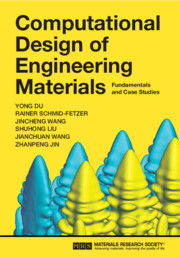
-
Select format
-
- Publisher:
- Cambridge University Press
- Publication date:
- 29 June 2023
- 29 June 2023
- ISBN:
- 9781108643764
- 9781108494106
- Dimensions:
- (244 x 170 mm)
- Weight & Pages:
- 1.18kg, 420 Pages
- Dimensions:
- Weight & Pages:
You may already have access via personal or institutional login
Book description
Introducing state-of-the art computational methods, this book combines detailed explanations with real-world case studies to give a full grounding in the design of engineering materials. This book presents a wide spectrum of key computational methods, such as CALPHAD-method, first-principles calculations, phase-field simulation and finite element analysis, covering the atomic-meso-macro scale range. The reader will see these methods applied to case studies for steel, light alloys, superalloys, cemented carbides, hard coating and energy materials, demonstrating in detail how real-world materials are designed. Online ancillary material includes input files for computational design software, providing the reader with hands-on design experience. Step-by-step instructions will allow you to perform and repeat the simulations discussed in the book. Aimed at both graduate and undergraduate students as well as non-specialist researchers in materials science and engineering, including ceramics, metallurgy, and chemistry, this is an ideal introductory and reference book.
Reviews
‘Computational Design of Engineering Materials - an ambitious title for an ambitious book! But the authors match that expectation! They carefully explain atomistic models like density functional theory and molecular dynamics simulations before going to mesoscale approaches like cellular automaton, the CALPHAD, multi-phase-field and the phase-field-crystal methods. This fundamental part of the book is complemented by several chapters addressing case studies. They are selected from different materials like steels, Al- and Mg-alloys and superalloys and also from examples of different applications like hard coatings or energy materials. The book concludes with a section on future development focusing on ICME (Integrated Computational Materials Engineering) and MGI (Materials Genome Initiative). A ‘must have’ for students and engineer of the material community.’
Georg J. Schmitz - Access e.V
Contents
Metrics
Full text views
Full text views help Loading metrics...
Loading metrics...
* Views captured on Cambridge Core between #date#. This data will be updated every 24 hours.
Usage data cannot currently be displayed.
Accessibility standard: Unknown
Why this information is here
This section outlines the accessibility features of this content - including support for screen readers, full keyboard navigation and high-contrast display options. This may not be relevant for you.
Accessibility Information
Accessibility compliance for the PDF of this book is currently unknown and may be updated in the future.


